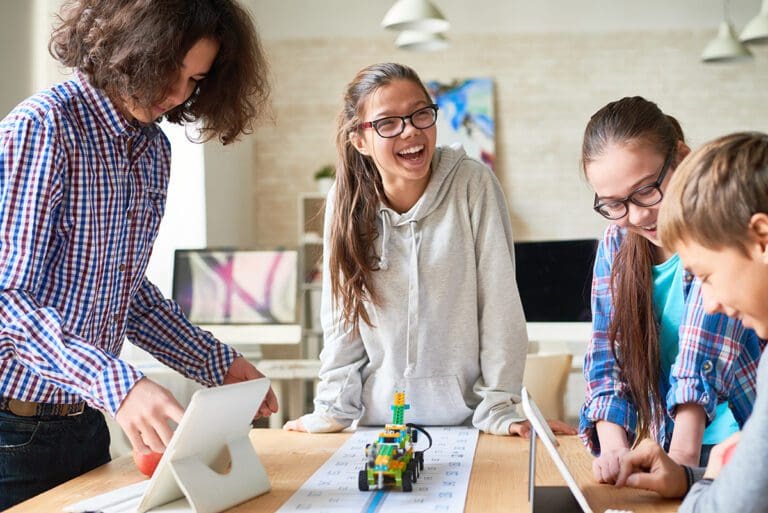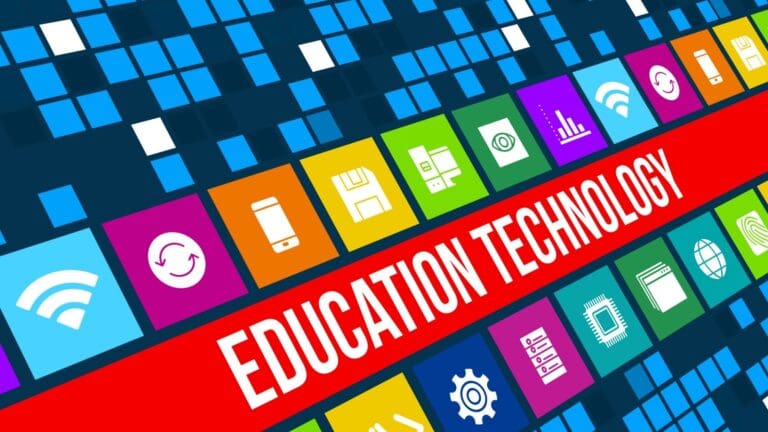Assistive Technology for Children: Learning Enhancement
As a parent, teacher, or caregiver, you may have come across the term “assistive technology” in the context of providing support for children with learning and developmental challenges. Assistive technology for children (AT) refers to devices, software, or equipment that help individuals with disabilities to learn, communicate, or function better in their daily activities. Whether it’s a high-tech computer or a low-tech walking stick, AT can significantly improve the lives of children with various types of disabilities.
For children with learning disabilities, assistive technology plays a crucial role in catering to their strengths and working around their challenges, aiding in their learning process. Examples of AT in the classroom include Braille displays, text-to-speech software, and wheelchairs, among many others. Early intervention and integration of assistive technology in your child’s life can boost their self-esteem, enhance learning, and encourage participation in activities for overall development (PACER Center).
Overview of Assistive Technology
Assistive technology (AT) can play a crucial role in supporting children with learning disabilities and other challenges. These tools help your child utilize their strengths and work around their limitations. They cater to a wide range of disabilities, including cognitive, physical, and sensory impairments.
AT comes in various forms and serves diverse purposes. Examples of assistive technology include text-to-speech software, customized keyboards, and visual or audio aids. Integrating these tools into a child’s daily routine allows them to gain independence, improve their overall learning experience, and enhance their self-esteem.
Choosing the appropriate assistive technology for your child relies on their specific needs and how the tool can adapt or align with their learning capabilities. Factors to consider include your child’s age, the severity of their disability, and the available resources or support systems. Remember, AT devices can range from low-tech tools, like raised line paper, to high-tech devices, like electronic wheelchairs and augmentative communication tools.
It is essential to stay informed about the advances in assistive technologies and learn from the experiences of other parents and professionals, as this will help you make informed decisions for your child. Websites like Reading Rockets and organizations like Nasen can provide valuable resources and guidance on this topic.
Types of Assistive Technologies for Children
As you explore assistive technology options for children, it’s important to understand that various types are available to support different needs. This section will discuss three main categories: Mobility Aids, Communication Devices, and Learning Tools.
Mobility Aids
Mobility aids are specifically designed to help children with physical disabilities navigate their environment more easily. These aids can include:
- Wheelchairs: These can be manual or electric-powered, allowing children to move independently.
- Walkers: These devices offer support to children who have difficulties with balance and strength but can still walk on their own.
- Crutches: Crutches can provide essential assistance for children who need extra support when walking or during recovery from injury.
- Prosthetics: Custom-built artificial limbs can replace missing body parts, enabling children to perform daily activities and maintain independence.
Communication Devices
Children with speech, language, or communication disorders can benefit from a range of devices that facilitate self-expression. Some of these devices include:
- Text-to-speech software: This software can help children with reading difficulties or verbal communication issues by converting written text into speech.
- Augmentative and alternative communication (AAC) systems: AAC devices can help children with severe communication difficulties express themselves. Examples include communication boards, speech-generating devices, and apps on tablets.
- Hearing aids: These devices amplify sound for children with hearing loss, enabling them to engage more fully in conversations.
Learning Tools
For children with learning disabilities, various tools and software applications can make learning more accessible and enjoyable. Some examples are:
- Reading and writing software: Tools that assist with word processing, spell checking, and text-to-speech functionality can provide support for children struggling with literacy.
- Organizational aids: Calendars, schedulers, and task management software can help children with executive functioning challenges stay organized and on track.
- Math tools: Specialized software and calculators designed for children with math difficulties can support learning and comprehension.
- Visual aids: Children with visual impairments might benefit from screen magnifiers, contrast adjustment tools, or braille displays to make text more accessible.
As you explore these categories, keep in mind that many assistive technology options can be customized to suit your child’s unique needs.
Assessment and Implementation
Assistive technologies can make a significant difference in the lives of children with disabilities. This section will guide you through the process of assessing your child’s needs and implementing the right tools to help them succeed.
Identifying Needs
The first step in the implementation of assistive technologies is to identify your child’s needs. You need to clearly understand their strengths, weaknesses, and the tasks they want to accomplish. It’s important to involve your child in this process, as they know best what issues they face and what could help them overcome these challenges.
Working with a team of professionals, such as educators, therapists, and specialists, will help you gather important assessment data. This will guide your decision-making and ultimately lead to better outcomes for your child. Collaborative efforts during the assessment phase will ensure a more comprehensive understanding of your child’s needs.
Finding the Right Tools
After identifying your child’s needs, the next step is finding the right assistive technology tools that can help them overcome their challenges. It’s important to research and consider a wide range of options, as what may work for one child might not be the best fit for another.
Some effective tools and resources for determining the right assistive technology include the Quality Indicators for Assistive Technology (QIAT) website (https://qiat.org/), the Functional Evaluation of Assistive Technology (FEAT), and the SETT process. By utilizing these resources and the input from professionals, you can make informed decisions about what tools are best suited for your child.
Once you’ve identified the appropriate assistive technology, creating an implementation plan that outlines the necessary steps, resources, and timelines is essential. This plan will help ensure a smooth transition and set your child up for long-term success with their new tools.

Benefits
Independence
Assistive Technology can provide your child with greater independence by enabling them to perform tasks they might otherwise struggle with. For example, a text-to-speech app could make a difference for a child with reading challenges by reading the text out loud for them. This allows your child to access information and complete tasks without relying on someone else’s help, leading to increased self-sufficiency and self-esteem Reading Rockets.
Social Inclusion
Another benefit of assistive technology is the promotion of social inclusion. With the appropriate tools, your child can participate in activities alongside their peers without feeling left out or isolated. For example, using an assistive listening device can help your child with hearing difficulties engage in conversations and group activities more inclusively PACER Center. In this way, assistive technology fosters connections and interpersonal relationships that can significantly improve your child’s overall well-being.
Academic Success
Assistive technology can contribute to your child’s academic success by providing tailored support that match their unique learning needs. Tools like readers, calculators, or writing aids can help your child compensate for learning challenges and empower them to perform at their best Child Mind Institute.
Moreover, assistive technology can save your child time and reduce frustration while working on tasks that are challenging due to their disabilities. This enables them to focus on learning and developing rather than being hindered by obstacles.
Assistive Technology for Kids with Learning Disabilities
Assistive technology (AT) can be a game changer for children with learning disabilities. It helps them overcome challenges, enhances learning experiences, and boosts their self-esteem.
What is assistive technology for learning disabilities?
Assistive technology refers to various tools, devices, and software that help individuals with different types of disabilities, including learning disabilities, to better cope with their challenges, work around obstacles, and improve their overall quality of life (Reading Rockets). These tools are designed to enhance your child’s strengths and bypass the barriers caused by their disability.
What types of learning problems does assistive technology address?
Assistive technology can address a multitude of learning problems, including those related to cognitive functions, problem-solving, reading, writing, math, and organizational skills. These tools empower children with various learning disabilities, including dyslexia, dysgraphia, dyscalculia, non-verbal learning disorder, attention deficit disorder, and executive functioning deficits.
What kinds of assistive technology tools are available?
Depending on your child’s needs, there is a vast array of assistive technology tools. Some examples include:
- Text-to-speech software: Helps children with reading difficulties by converting written text into spoken words.
- Speech recognition programs: Allows children with writing challenges to dictate their thoughts and have them typed automatically.
- Electronic graphic organizers: Helps with organizing information, enhancing understanding, and improving the planning of written work.
- Calculators and math software: Provides visual or auditory support for children struggling with math concepts.
Factors to consider when evaluating AT products for your child
Before selecting an assistive technology tool for your child, consider the following factors:
- Individual needs: Ensure that the AT tool addresses your child’s specific learning challenges and enhances their strengths.
- Usability: The AT product should be user-friendly and age-appropriate for your child to use effectively.
- Compatibility: Ensure the chosen AT tool is compatible with your child’s existing software, hardware, or devices.
- Cost: Assess whether the AT product fits within your budget and explore possible support avenues, such as school or insurance funding.
Remember that every child is different. As a parent, you play a crucial role in assessing the suitability of assistive technology tools for your child and helping them utilize these tools for improved learning outcomes.
Challenges and Limitations
While assistive technology for children with disabilities can be a game changer, it’s important to recognize some of the challenges and limitations that can arise. This section will discuss the costs, accessibility, and training associated with assistive tech.
Costs
One major challenge you might face is the cost of assistive technology, which can vary widely depending on the device and its features. Some simple tools, like pencil grips or stress balls, may be affordable for most families, but more complex devices, like communication tools or specialized software, can be more expensive. Exploring funding options in your area, such as government programs, insurance coverage, or grants from charitable organizations like PACER Center, is essential.
Accessibility
Another challenge can be the accessibility of assistive technology. Certain tools or devices may not be readily available depending on your location, or you may face a limited selection of options. Additionally, some children with disabilities may have multiple or complex needs that are not easily addressed by a single tool or device. When assessing your options, consider researching online resources and consulting with professionals to learn the best solutions for your child’s needs.
Training
Lastly, you may encounter challenges related to training for both you and your child. Assistive technology devices can require considerable effort to learn and adapt to. Both the child and those supporting them, including parents and educators, should be prepared to invest time into learning how to use and support the use of technology properly. Many Reading Rockets and other organizations offer helpful guides and tutorials to assist with the integration of assistive technology devices into daily routines.
Future Developments
As technology continues to advance, you can expect exciting new developments in the field of assistive technology for children. In the coming years, accessibility and inclusion will be increasingly emphasized, with innovations aimed at enhancing the learning experience and daily life of children with disabilities.
One area of focus will likely be improving the integration of assistive technology in the classroom. Developers will work on creating more user-friendly interfaces, making it easier for both students and educators to adopt and adapt to new tools. Furthermore, with the increased emphasis on personalized learning, you can expect more tailored approaches in assistive technology catering to individual needs.
Another future development is likely to be early childhood assistive technology advancement. Innovations will come in the form of new devices and adaptations that help young children with disabilities to participate more actively in their world, expanding their opportunities for play, communication, and mobility. Technological advancements, such as 3D printing, might become more accessible to customize assistive equipment to suit each child’s unique needs.
Artificial intelligence (AI) will also play a significant role in the future of assistive technology. With advancements in machine learning and natural language processing, tools like text-to-speech and speech-to-text software will become more accurate, realistic, and efficient, greatly enhancing the overall functionality and user experience. Additionally, AI-driven technology may enable predictive tools that anticipate the individual’s needs, making interactions with devices more intuitive.
In conclusion, the future of assistive technology for children holds great promise. Keep an eye on developments in this field, as they are bound to bring even more innovative and effective tools to support children with disabilities in learning, communication, and daily life.
FAQ
What is assistive technology for children with special needs?
Assistive technology (AT) is a broad term that refers to devices, tools, and strategies that support children with special needs by helping them overcome challenges, build skills, and participate more fully in activities. These technologies can promote development, enhance learning, and boost self-esteem in young children who may struggle with disabilities or learning difficulties.
What is assistive technology, and what examples?
Assistive technology ranges from low-tech to high-tech solutions. Some examples of AT devices include:
- Modified pencils and grips for improved handwriting
- Bookholders and page turners for easier reading
- Visual timers and schedules to aid in time management
- Text-to-speech software for reading support
- Speech-to-text software for writing and communication assistance
- Alternative keyboards and touchscreens to support mobility and motor skills
These are just a few examples, and the right assistive technology for your child will depend on their specific needs and challenges.
Why do we use assistive technology?
Assistive technology is used to support children with special needs because it can help address their specific challenges and empower them to achieve their full potential. AT provides additional opportunities for children to participate in activities independently, develop crucial skills, and enhance their overall learning experience.
By using the appropriate assistive technology, your child can gain confidence, improve their self-esteem, and feel more engaged in their education and daily life. Working closely with your child’s educators and professionals is essential to determine the most suitable AT tools and strategies that will cater to their unique needs and strengths.







